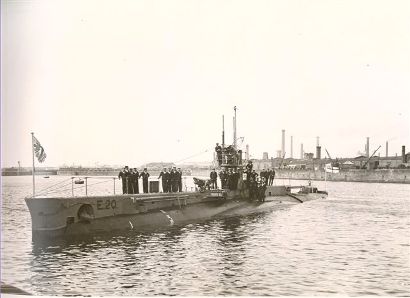Cumberland Council has now replaced the previous Cumbria County Council and 3 District Councils. The content on this website is still relevant including documents that may include the old county council logo. Find out about the council changes
Please update any cumbria.gov.uk browser shortcuts you may have to the new site pages as needed
Industry



Barrow-in-Furness in World War I
As a major British warship and armaments manufacturer Vickers Ltd was kept very busy during the war. The company's Barrow shipyard built submarines for the Royal Navy, as it still does today, and large quantities of artillery pieces and munitions were also produced. Many of the navy's warships at the outbreak of war in 1914 had been built in Barrow during the arms race that preceded the conflict, and during the war the same yards produced fifty more submarines, six cruisers, a battleship, eleven cargo ships, an oil tanker, twelve canal barges and fourteen troop barges. Vickers also built airships in Barrow.
Although many workers in Barrow were in reserved occupations, such as shipbuilding dock and foundry work, which contributed directly to the war effort and therefore gave exemption from conscription, an appeal by the government for women to register for war work - which included the manufacture of armaments and munitions, factory work, clerical work, transport, farm work, nursing, postal work, police work, and sewing - led to an influx of women workers and a consequent rise in the population of Barrow from 68,000 in 1914 to 90,000 at its peak in 1917. Dilution of tasks (the employment of several women on parts of a skilled man's work, often divided into simplified sections) meant that more women were employed than men were lost to active service. The town's other employers, such as the iron works and foundries, docks, trams, buses, railways and shops also hired women to do what had before the war been seen as men's work.
The rise in population in a town already notorious for its overcrowding, coupled by two strikes at Vickers Ltd in 1916 and 1917 which raised fears that insufficient housing, high rents and the practices of dividing families in different houses and sharing beds between different shift-workers could lead to social unrest, acted as a stimulus to house-building, both by the local government and by Vickers Ltd which built more streets in Vickerstown, the company's housing estate.on Walney Island.
Although rates of pay for women were only half to two-thirds of men's wages, many women gained economic independence for the first time in their lives, only to lose it again after the Armistice when men returned from active service to their jobs and ship and munitions orders were cancelled.
How a Carlisle dye-maker managed to beat Germany
Denis Perriam
In a lecture in the School of Chemistry at Tullie House, Carlisle, in 1923 R Fraser-Thomson gave an account of The Manufacturer of Dyes in Carlisle. He was introduced by local industrialist Sir Frederick Chance as 'the first research chemist engaged at the Murrell Hill Colour Works'. These works on Lorne Crescent, Carlisle, opposite the Denton Hill Works of Morton Sundour, are shown on the 1924 OS map. The building fronting Lorne Crescent, the laboratory for the colour works, has over the door 'M' for Morton and the date, 1918. Alexander Morton and Co ( later Morton Sundour) bought the former Denton Hill Works of Donald brothers in 1900 and after refurbishment began textile manufacture in 1901. The production of coloured cloth there was threatened in 1914 with the outbreak of the war. Chemical dyes had been developed in Germany to such an extent that Sir Frederick Chance said 'We allowed ourselves to get into the humiliating position of being dependent on Germany for 80 per cent of our dyes'. In his book, Three Generations in a Family Textile Firm, Jocelyn Morton explains that Morton Sundour 'by taking quick action, was able to secure sufficient stocks of the vat dyestuffs…for about five months.'
German suppliers thought there was no possibility of anyone learning their secrets and then making these dyes within 10 years, but James Morton of Morton Sundour set out to prove them wrong. By obtaining German patents from the patent Office in London and analysing their dyes James Morton's chemists were able to produce blue and yellow vat dyes in sufficient quantities to supply the factory by March 27 1915. The confined site of the colour works, with nearby housing presented problems. Fraser-Thomson said: 'Purification entailed the use of an evil-smelling oil derived from coal-tar, making the neighbourhood decidedly unpopular for a short time, until improved plant and methods removed the annoyance.' Not only did Morton Sundour manufacture substitutes for German dyes in quantity, but they also produced new colours. Many of these new products were protected by patents taken out by Morton Sundour. When in November 1916, a rival firm, British Dyes Ltd, advertised that they had placed on the market Indanthrene Blue which they boasted had been 'produced in little over two years from the outbreak of the war,' James Morton was incensed. He wrote to the newspapers in which the advert had appeared 'in case German chemists or others may think this the high-water mark of British accomplishment in dye making, I would inform your readers that my firm produced Indanthrene Blue and several other dyestuffs within six months of the outbreak of the war. In the past eighteen months many thousands of pieces of cloth have been supplied to all parts of the world dyed with these special colours made exclusively by us'.
There had been no publicity for this process until now, as production in Carlisle had remained something of a secret. This did not deter similar claims being made again by British Dyes Ltd and this time James Morton was more scathing: 'We have not seen fit to make public announcements in the press on every occasion when we have succeeded in making a colour, because we feel that to produce something that is carefully described in a German patent is nothing to throw one's cap in the air about.'. Later, James Morton said 'Criticism has sometimes been lodged against British dye-makers because they were not more advanced in their production by 1918.' He explained; 'Not only were all mainly engaged on other work essential to the war, but the elements that go to the making of dyes were scarcely procurable.' Under the name of Solway Dyes Company, a subsidiary of Morton Sundour, Murrell Hill Colour Works produced in 1919 half of the total pre-war British consumption of dyestuffs and, with British dye manufacture protected for 10 years by a post-war foreign import ban, the company flourished, but not for long.

